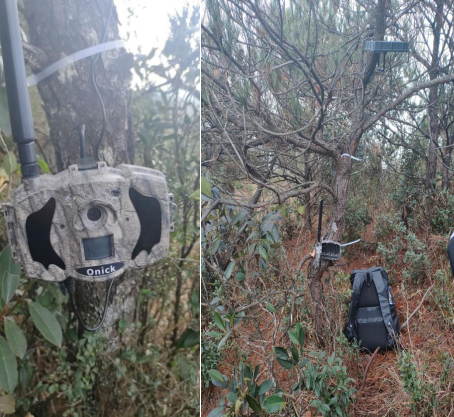Infrared camera technology mainly refers to the use of automatic cameras triggered by heat changes (temperature differences) to record images of animals passing in front of them, and to identify species and their distribution and habits through these images. Due to its advantages such as low power consumption, compact and easy to carry, high image quality and strong tolerance to harsh environments, researchers can deploy a large number of infrared cameras in a wide area at the same time and work continuously for several months, thereby obtaining a large amount of species information. Considering that many animals are highly mobile, secretive and afraid of humans, unattended infrared camera technology has obvious advantages over traditional wildlife manual surveys (such as using animal footprints, feces and other traces). In addition, infrared camera monitoring is non-destructive and does not require the capture of live animals, which generally improves the efficiency of researching and protecting cryptic and rare species.
After decades of development, the use of infrared cameras to collect wildlife image data has been widely carried out around the world, forming an important source of global biodiversity big data. At present, infrared camera technology has become one of the main tools for studying terrestrial mammals and birds, and can strengthen monitoring efforts on a larger spatial and temporal scale, thereby generating a large amount of new information on the distribution and abundance of animal species, which is crucial for understanding the current status of conservation and proposing solutions to problems. The image data obtained by the infrared camera contains basic information such as species, location, behavior, date, time, and weather. These data have high resolution, wide coverage, and a wide range of sources. They can not only provide rich, multi-dimensional dynamic data on species distribution and abundance, but also record relevant characteristics such as the behavior of various animals, enabling researchers to better predict and manage species and ecosystems that may undergo major changes.
Since the 1990s, infrared camera technology has been widely used in wildlife surveys and research in China. After 2010, with the emergence and widespread application of digital passive infrared cameras, coupled with their significant cost reduction, small size and lightness, and significantly improved shooting quality and capacity, such cameras have been gradually promoted throughout China. So far, almost all national-level terrestrial ecosystem types of nature reserves, national parks, etc. use infrared cameras to monitor wildlife.
The onick Optical Organization has developed an infrared camera network real-time monitoring information sharing service platform with automatic data collection, real-time wireless transmission, intelligent identification and visualization, and cloud services (cloud platforms) as core technologies, which further improves the efficiency of massive image data collection, storage, and analysis and processing, and provides an important data basis for national-scale data sharing and scientific evaluation and analysis.
Onick AM-36 wildlife infrared monitoring camera supports up to 36 million pixel high-definition photography and 1920x1080 high-definition video shooting. The machine starts up quickly, the image is clear, and the color is true. It supports GPS location input and can display the camera's location on the picture.

AM-36 infrared monitoring camera supports 4G image transmission function and can be equipped with our independently developed cloud platform image processing system to perform AI recognition, data statistics and analysis on the captured pictures and videos. It can also be used with mobile phone APP to remotely control the camera, remotely control the parameters of the mobile phone to remotely see the scene in real time. It can integrate a set of big data management, camera management, image monitoring and wireless Internet of Things, and an animal and plant monitoring system with precise GPS positioning, which can realize mobile phone APP and Internet of Things all-weather monitoring solutions.
onick Optics has a variety of models of infrared trigger cameras, with MMS, without MMS, and multiple types of infrared trigger cameras that support 4G image transmission, and has the company's independently developed cloud platform management system and mobile phone APP. It can better assist in wildlife ecological diversity monitoring and ecological environment management monitoring in various nature reserves or forest parks. We have rich working experience and successful cases in protected areas, professional staff and strong product and company qualifications. Welcome customers and friends who have project cooperation to contact onick optics!

